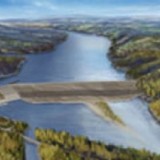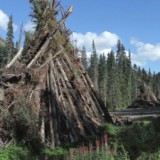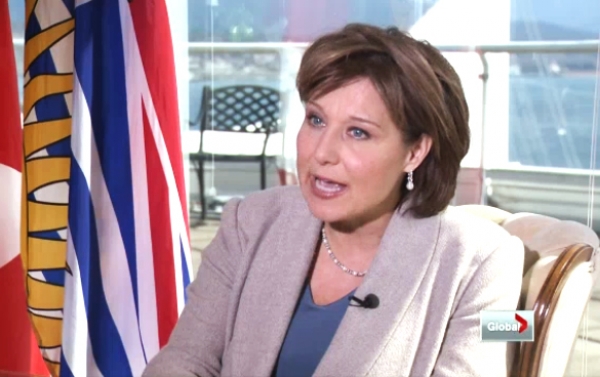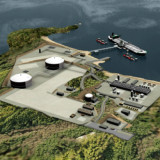The following is an open letter by independent economist andCommon Sense Canadian contributor Erik Andersen to the leaders of BC’s four major political parties on the eve of the May 14 provincial election.
Dear Ms. Clark, Mr. Dix, Ms. Sterk and Mr. Cummins,
I am writing to all of you political party leaders in the midst of the BC provincial campaign, as a senior economist who is very concerned that the proposed construction of Site C dam on the Peace River may push our provincial indebtedness beyond its already critical level.
The disclosed total liabilities of the province a year ago, according to government’s own figures, were $70 billion. In addition, the Auditor General confirmed that as of a year ago BC’s “Contingencies and Contractual Obligations” totaled another $96.374 billion. By the time the dust settles, the fiscal year just ended (2012/13) will likely have the provincial total liabilities closing in on $200 billion. The bulk of the nearly $100 billion of contractual obligations come from the IPP contracts to which Hydro has committed us.
Site C represents the addition of at least $8 billion to the already seriously bloated debt load directly associated with BC Hydro and its exaggerated expectations from industrial “want-a-be’s”.
Over the course of the past four decades the need for a Site C generation facility has been part of the larger and exaggerated demand narrative BC Hydro has been telling. The demand exaggeration theme goes as far back as 1961. It is no different today.
Where is the evidence of future need? It is certainly not from residential and commercial customers in BC (which has actually decreased on average since 2008). The future need, as stated repeatedly by the Liberal government of late, is strictly industrial, specifically the proposed LNG plants.
But the irony, not missed by many, is that by the design of the rate structure, we are expected to shoulder the financial burden that is created when Hydro contracts/builds at costs of +$100,000 per GWhr per year yet plans to sell to their new “best friends” at $35,000 per Gwhr per year. This is not new for Hydro . Hydro’s narrative of greater future need is just as before, a fiction created to be the cover for a ‘borrow and build into financial oblivion’ strategy. Site C is one important element in this flawed narrative.
One must consider the “market” prices for electricity are in the western part of North America. These are the best indicators to determine whether electricity is currently in surplus or shortage. While Hydro has been buying electricity from IPPs at $100,000 per GWhr or greater, Powerex has reported selling, on average, at $20,000 per GWhr in the past three years.
In 2011, the volumes indicated a large regional imbalance between electricity generation capacity and regional demand. In such circumstances, it is a very high risk strategy to build more capacity until there is evidence of sustained higher prices, indicating demand has tightened. We are a very long way from this condition, making the Site C plan irrelevant for a long time to come if not permanently, as new energy technologies are integrated in the future.
On the evidence there seems no case for the development of Site C. Hydro is financially crippled because it not only produced fictional narratives about future demand, but worse, acted on these exaggerations with tens of billions in contractual long-term obligations with IPP’s. Secondly, to knowingly build a new generation facility that needs to sell at $100,000 per GWhr or more in order to break even – when the regional demand for electricity is decidedly weak and expected to remain so for a long while, is absurd. I don’t see Hydro customers, i.e., the voting public, thinking that is a good idea.
Clearly, it’s time to “draw a line in the sand” and say no to Site C.
Sincerely,
Erik Andersen, Economist
——————————————————————————-
References:
BC Hydro audited reports for the past 12 years
Annual BC Hydro demand forecasts for the past 12 years
Annual Reports by the BC Auditor General
Personal correspondence between Erik Andersen and the Auditor General of BC, Feb 19, 2013
“White Gold: Hydroelectric Power in Canada,” Karl Froschauer
http://thecanadian.org/k2/item/543-new-report-bc-hydro-driving-rates-higher
http://thecanadian.org/item/2045-bc-liberal-legacy-a-huge-debt-burden
BC Ministry of Finance, Provincial Debt Summary/ Debt Statistics
BC Ministry of Finance, Contractual Obligations Supplemental/Public Accounts/Summary Financial Statements
Links to data sources for total provincial debt:
http://www.fin.gov.bc.ca/ocg/pa/11_12/PA%20Prov%20Debt%20Summary%2011-12.pdf
http://www.fin.gov.bc.ca/ocg/pa/06_07/PA_2007_ProvDebt.pdf
http://www.fin.gov.bc.ca/debtmgmt/debtstat01-02.pdf
http://www.fin.gov.bc.ca/debtmgmt/debstat00-01.pdf
Links to data sources for contractual obligations:
http://www.fin.gov.bc.ca/ocg/pa/11_12/Contractual_Obligations.pdf
http://www.fin.gov.bc.ca/ocg/pa/10_11/Contractual_Obligations.pdf
http://www.fin.gov.bc.ca/ocg/pa/09_10/Contractual_Obligations.pdf
http://www.fin.gov.bc.ca/ocg/pa/08_09/Contractual_Obligations.pdf
http://www.fin.gov.bc.ca/OCG/pa/07_08/PublicAccounts.pdf
http://www.fin.gov.bc.ca/OCG/pa/06_07/PublicAccounts.pdf
http://www.fin.gov.bc.ca/ocg/pa/05_06/PA_2006_Summ.pdf
http://www.fin.gov.bc.ca/ocg/pa/04_05/PA_2005_Summ.pdf












